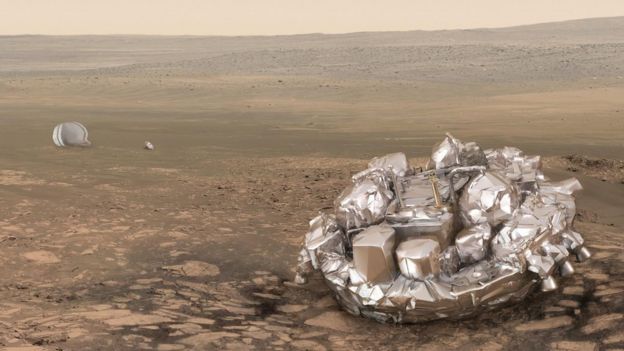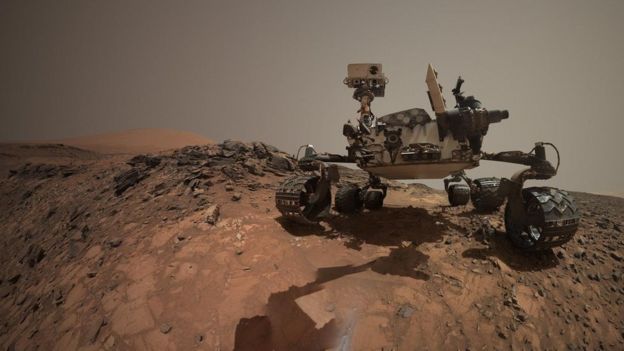
The satellite, called the ExoMars Trace Gas Orbiter (TGO), lifted off from Baikonur in Kazakhstan at 09:31 GMT.
The probe will investigate whether the methane in the world’s atmosphere is coming from a geological source or is being produced by microbes.
If all goes well, the two space powers expect to follow up this venture with a rover, to be assembled in the UK, which will drill into the surface.
That could launch in 2018, or, as seems increasingly likely, in 2020.
It will take the carrier rocket more than 10 hours to put the satellite on the right trajectory to go to Mars.
This involves a series of engine burns by the Proton’s Breeze upper-stage to build up the velocity needed to break free of Earth’s gravity.
These will fling the TGO away from Earth with a relative velocity of 33,000km/h.
The flight sequence is sure to strain the nerves of space agency officials.
For Russia especially, the Red Planet represents a destination of wretched fortune.
It has previously launched 19 missions to the fourth planet from the Sun, and most of those have been outright failures.
Many could not get off the pad cleanly; others simply stalled above the Earth and fell back down; a few crashed and burned at Mars or sailed straight past.
Assuming everything works out this time, controllers at the European Space Agency’s operations centre in Darmstadt, Germany, can expect a signal from the TGO after it has been released on its way by the Breeze boost stage.
This should come through at 21:28 GMT. It is then a seven-month cruise to Mars.
 Image copyrightESA
Image copyrightESAThree days out from arrival, on 16 October, the satellite will eject a small landing module known as Schiaparelli.
Once on the surface, on 19 October, its aim is to operate a few science instruments, but engineers are primarily interested to see how the module performs during the entry, descent and touchdown.
In particular, Schiaparelli will showcase a suite of technologies – radar, computers and their algorithms – that will be needed to put a later, British-built rover safely on the planet.
This second step in the joint European-Russian ExoMars project is supposed to leave Earth in 2018, although this is now looking increasingly doubtful because of funding and scheduling issues. Many connected with ExoMars are now talking about 2020 as being a more realistic launch date.
Schiaparelli’s demonstration landing on 19 October
 Image copyrightESA
Image copyrightESA- Schiaparelli will be released by the TGO close to Mars, on 16 October
- The probe will hit the top of the Martian atmosphere at a speed of 21,000km/h
- It will use a heatshield, parachute and rockets to slow its descent
- The final touchdown will be cushioned by crushable material on its belly
- The probe will take pictures on the way down, but it has no surface camera
- Schiaparelli will make environmental observations until its battery dies
- The main goal is to demonstrate its descent radar, computers and algorithms
- These will be used in the mechanism that lands the future ExoMars rover
None of this affects the TGO mission, however.
After it has dropped off Schiaparelli, the satellite will spend the better part of a year manoeuvring itself into a 400km-high circular orbit above Mars.
From this vantage point, the orbiter’s state-of-the-art instruments will then make a detailed inventory of Mars’ atmospheric gases.
Methane is the key interest. Previous observations – by satellite, Earth-based telescopes and America’s Curiosity rover on the surface of the planet – found the hydrocarbon to be present in very low concentrations, at just a few parts per billion by volume.
That it is there at all is surprising. Ultraviolet light should remove the gas from the atmosphere within a few hundred years, which suggests it must be replenished somehow.
 Image copyrightNASA/JPL-CALTECH/MSSS
Image copyrightNASA/JPL-CALTECH/MSSSOne possible active source involves geological activity at depth, where water could be reacting with rock minerals to produce hydrogen, which is then further processed into methane.
Another tantalising prospect is that the source is biological in origin.
Most of the methane in Earth’s atmosphere comes from microbes, like those in the stomachs of ruminants.
There are no cows on Mars, but simple organisms could conceivably be operating just below the surface of the planet.
The TGO’s measurements should throw some light on these competing ideas.
Russia’s torrid history of Mars missions
- Marsnik 1 (1960): Mars flyby – did not reach Earth orbit
- Marsnik 2 (1960): Mars flyby – did not reach Earth orbit
- Sputnik 22 (1962): Mars flyby – achieved Earth orbit only
- Mars 1 (1962): Mars flyby – radio failed at 106 million km
- Sputnik 24 (1962): Mars flyby – achieved Earth orbit only
- Zond 2 (1964): Mars flyby – passed Mars but radio failed, returned no planetary data
- Mars 1969A (1969): Mars orbiter – did not reach Earth orbit
- Mars 1969B (1969): Mars orbiter – failed during launch
- Kosmos 419 (1971): Mars lander – achieved Earth orbit only
- Mars 2 (1971): Mars orbiter/lander – arrived but limited data return; lander burned up due to steep entry
- Mars 3 (1971): Mars orbiter/lander – arrived but limited data return; lander operated on surface for 20 seconds before failing
- Mars 4 (1973): Mars orbiter – flew past Mars
- Mars 5 (1973): Mars orbiter – arrived, lasted a few days
- Mars 6 (1973): Mars flyby module and lander – arrived but lander failed due to fast impact
- Mars 7 (1973): Mars flyby module and lander – arrived but lander missed the planet
- Phobos 1 (1988): Mars orbiter and Phobos lander – lost en route to Mars
- Phobos 2 (1988): Mars orbiter and Phobos lander – lost near Phobos
- Mars 96 (1996): Mars orbiter/two landers/two penetrators – launch vehicle failed
- Phobos-Grunt (2011): Phobos lander and sample return – achieved Earth orbit only
 Image copyrightMOLA
Image copyrightMOLA Image copyrightESA
Image copyrightESA[Source:- BBC]





